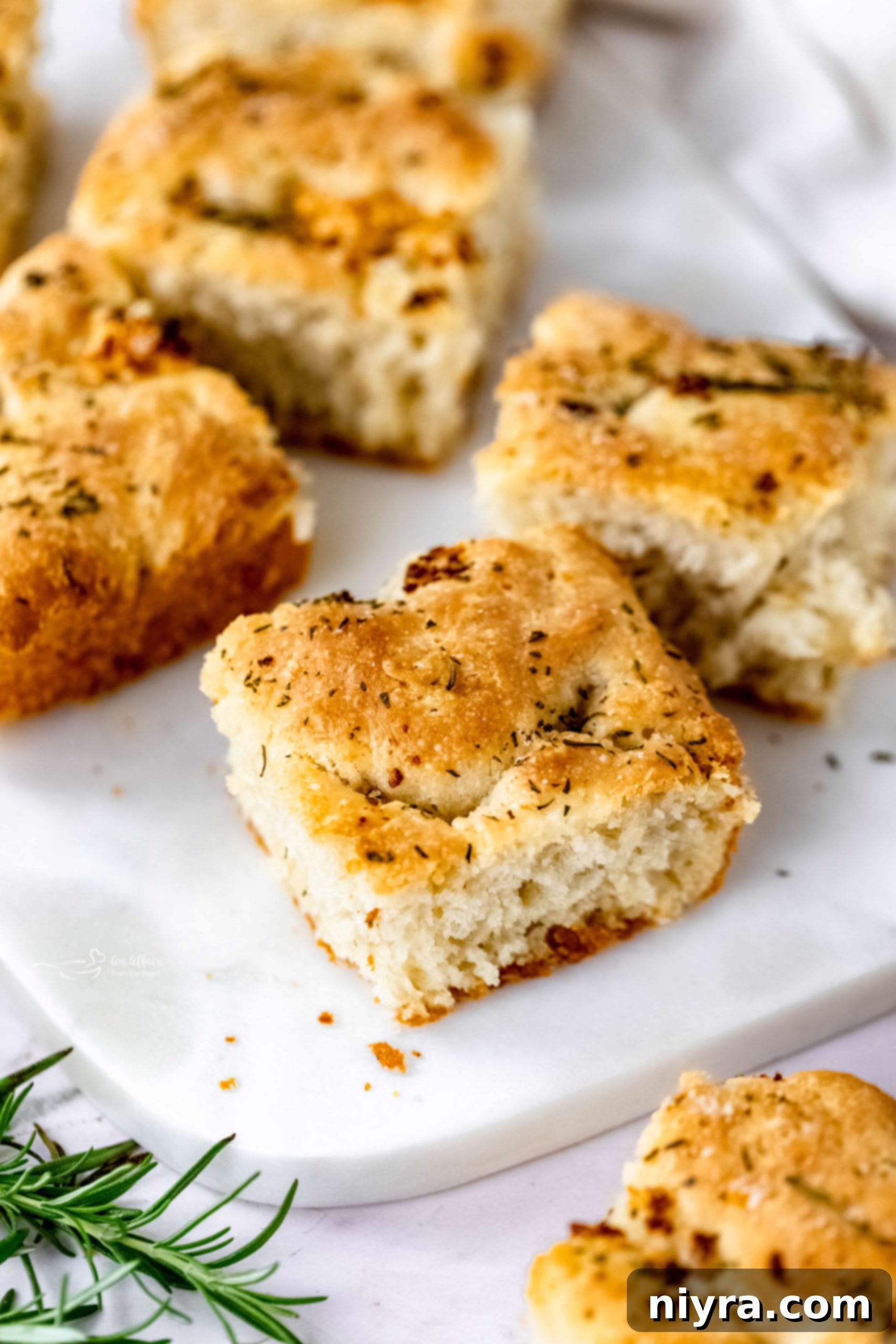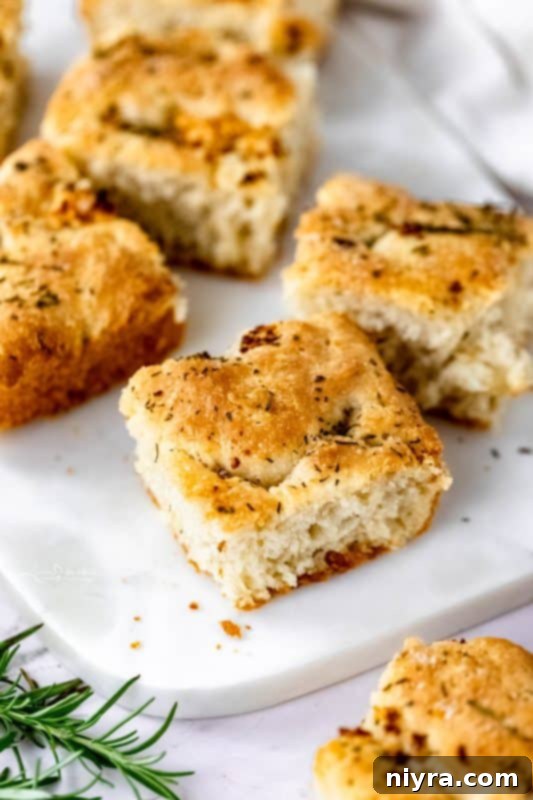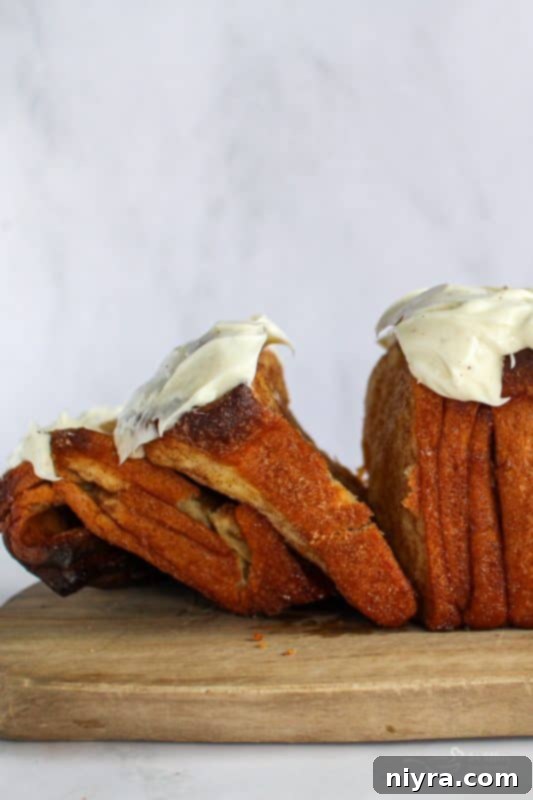Indulge in the irresistible aroma and delightful texture of homemade focaccia with this incredible Garlic Rosemary Focaccia Bread recipe. Perfectly crafted to deliver a crispy, golden crust that crackles with every bite, while the interior remains wonderfully airy and soft. This Italian flatbread is not just a dish; it’s an experience, whether you’re dipping it in olive oil, crafting gourmet sandwiches, or simply enjoying a slice on its own. Prepare to elevate your baking game and impress your family and friends with this surprisingly simple yet utterly delicious bread.

Unlocking the Secrets of Homemade Focaccia Bread
If you’ve never ventured into baking focaccia bread at home, you’re in for a delightful surprise. Many assume homemade bread is a complex endeavor, but focaccia stands out for its straightforward process and rewarding results. This beloved Italian flatbread bakes beautifully in a standard baking pan after a single, relatively short rise, making it accessible even for novice bakers. The beauty of this recipe lies in its adaptability; while we’re focusing on the classic and utterly delicious combination of fresh garlic and aromatic rosemary, the focaccia dough itself is a versatile canvas. Feel free to experiment by topping it with your favorite herbs, a medley of colorful vegetables, or even a sprinkle of cheese for a personalized touch.
Why This Focaccia Bread Recipe Is a Must-Try
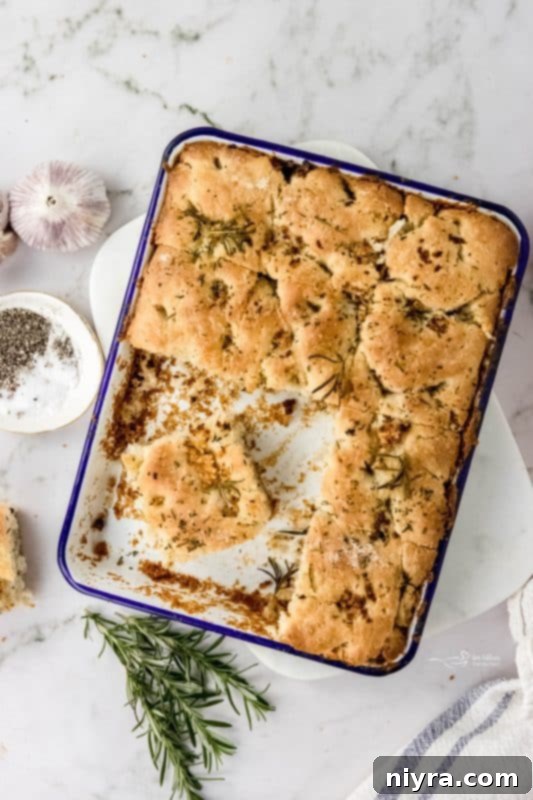
Beyond its ease of preparation, focaccia bread is incredibly versatile, making it a staple in any kitchen. It can be enjoyed purely on its own, allowing the rich flavors of olive oil, garlic, and rosemary to shine. For a more traditional Italian experience, serve it with a side of high-quality extra virgin olive oil and a splash of balsamic vinegar for dipping. Its sturdy yet soft texture also makes it an ideal candidate for crafting robust sandwiches, holding up well to a variety of fillings. This bread is perfect for entertaining; I often present it as an appetizer when guests arrive, accompanied by flavorful dips like a creamy spinach dip or a zesty bean dip. Even leftover focaccia retains its deliciousness the next day, and a quick pop in the toaster oven will restore its delightful crispness. If you’re a fan of the aromatic rosemary focaccia, you’ll surely love exploring other bread recipes like Pepperoni Pizza Bread, Everything Sauerkraut Bread, or Dorothy’s Cheesy Bacon Pull Apart Bread for more delightful homemade treats.
The Allure of Garlic Rosemary Focaccia
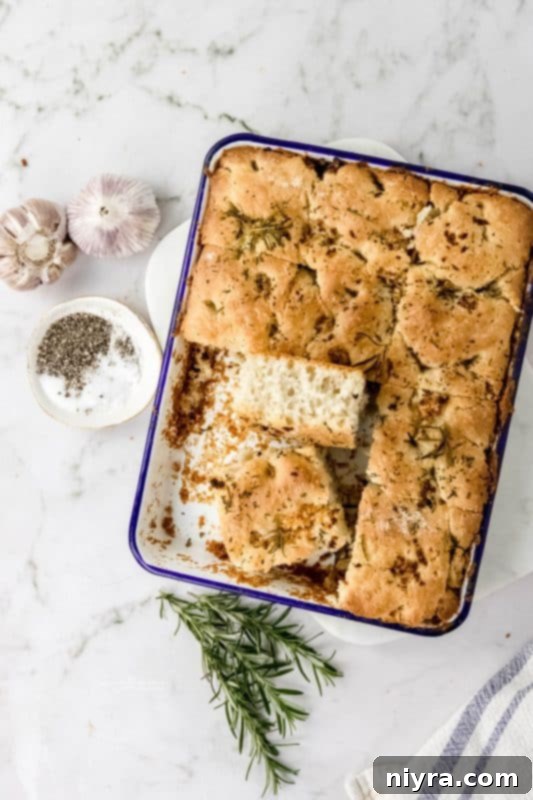
This straightforward focaccia recipe is designed to be user-friendly, ensuring success even if this is your very first time baking Italian bread from scratch. You’ll quickly discover that it’s one of the most forgiving and easiest breads to bake. The recipe is streamlined, requiring only a single rise, which significantly cuts down on preparation time and allows for a surprisingly quick bake. The combination of pungent garlic and fragrant rosemary infused into the dough and sprinkled on top creates an irresistible aroma that will fill your kitchen and tantalize your taste buds. This isn’t just bread; it’s a sensory journey that culminates in a profoundly satisfying culinary creation.
Essential Ingredients for Perfect Homemade Focaccia Bread

Crafting the perfect focaccia requires a few simple, high-quality ingredients. For a complete list of quantities and detailed instructions, refer to the printable recipe card below. However, understanding the role of each ingredient can enhance your baking experience and help you achieve the best results.
- Olive Oil: A cornerstone of Italian cuisine, olive oil is crucial for focaccia. It’s used in the dough, to generously coat the pan, and for drizzling on top, contributing significantly to the bread’s characteristic flavor, tender crumb, and crispy crust. Extra virgin olive oil is preferred for its superior flavor, but regular olive oil works well too.
- Warm Water: The ideal temperature for activating yeast is typically between 105-115°F (40-46°C). Water that’s too cold won’t activate the yeast, and water that’s too hot can kill it.
- Salt: Essential for flavor balance and controlling yeast activity. Any type of salt can be used – table salt, kosher salt, or flaky sea salt for sprinkling on top – but ensure it’s properly measured.
- All-Purpose Flour: You don’t need specialized bread flour for this recipe. Standard all-purpose flour provides the perfect structure and texture for focaccia, yielding a soft yet chewy interior.
- Instant Dry Yeast: This type of yeast is convenient as it can be mixed directly with the dry ingredients and doesn’t require proofing. It ensures a reliable rise for your focaccia. Active dry yeast can also be used, though it might require a slightly longer rising time and often benefits from being proofed in warm water first.
- Fresh Garlic Cloves: Minced fresh garlic infuses the bread with a rich, aromatic flavor that is central to this recipe. The warmth of the oven mellows the garlic, making it delightfully fragrant.
- Fresh Rosemary Sprigs: Chopped fresh rosemary adds a distinct, earthy, and piney aroma that complements the garlic beautifully. Fresh herbs are always recommended for their vibrant flavor, but dried can be used in a pinch (use about 1/3 the amount of fresh).
Step-by-Step Guide to Crafting Garlic Rosemary Focaccia Bread
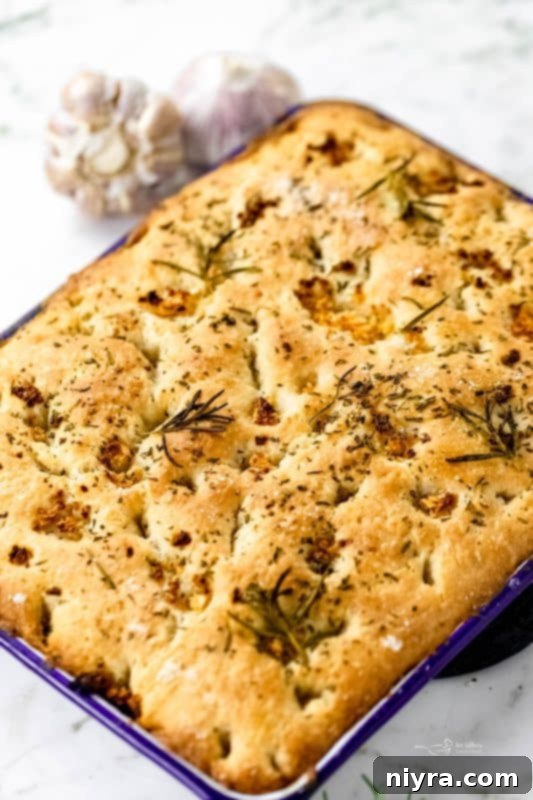
If you once believed homemade bread was a laborious task, this recipe is here to change your mind. The simple steps below will guide you to a perfectly baked focaccia, making the process enjoyable and the outcome incredibly satisfying.
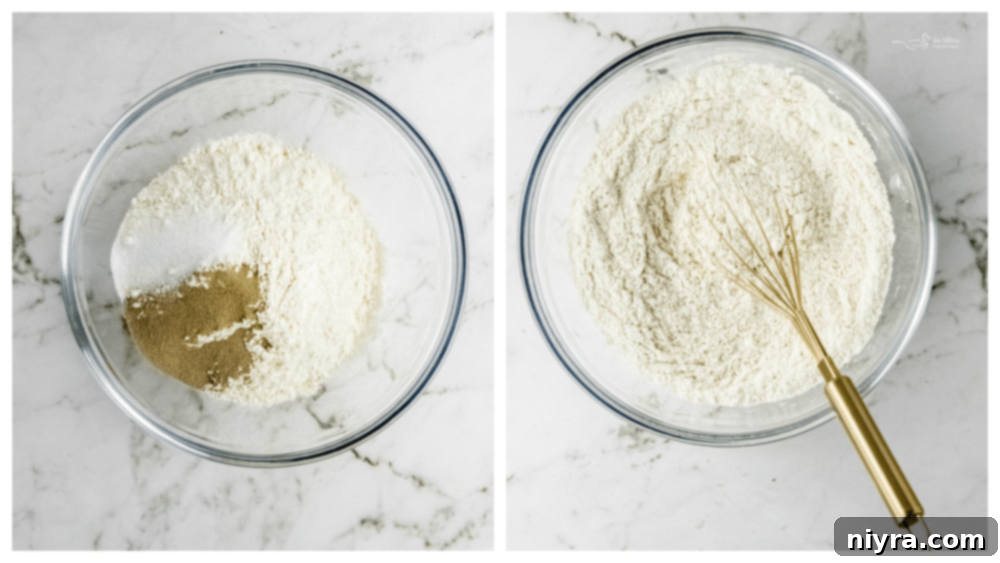
First: Combine Dry Ingredients. In a large mixing bowl, thoroughly combine the all-purpose flour, salt, and instant dry yeast. Whisk them well to ensure the yeast is evenly distributed, which is crucial for a consistent rise.

Second: Add Wet Ingredients. Create a small well in the center of your flour-yeast mixture. Pour in the warm water and 3 tablespoons of olive oil. The well helps prevent the liquids from spilling over as you begin to mix.
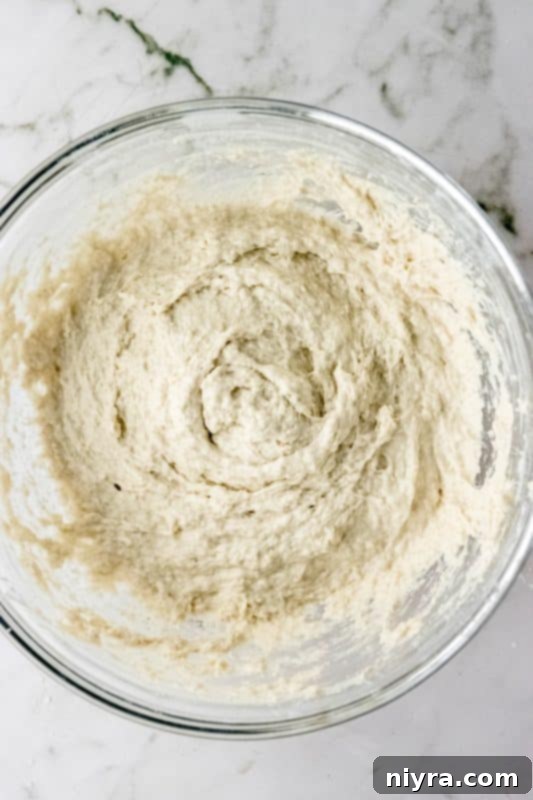
Third: Mix the Dough. Using your hands or an electric mixer with a paddle attachment, beat the dough until all ingredients are well combined and a shaggy, somewhat sticky dough forms. This usually takes 1-2 minutes. Make sure to scrape down the sides of the bowl as needed to incorporate all the flour.
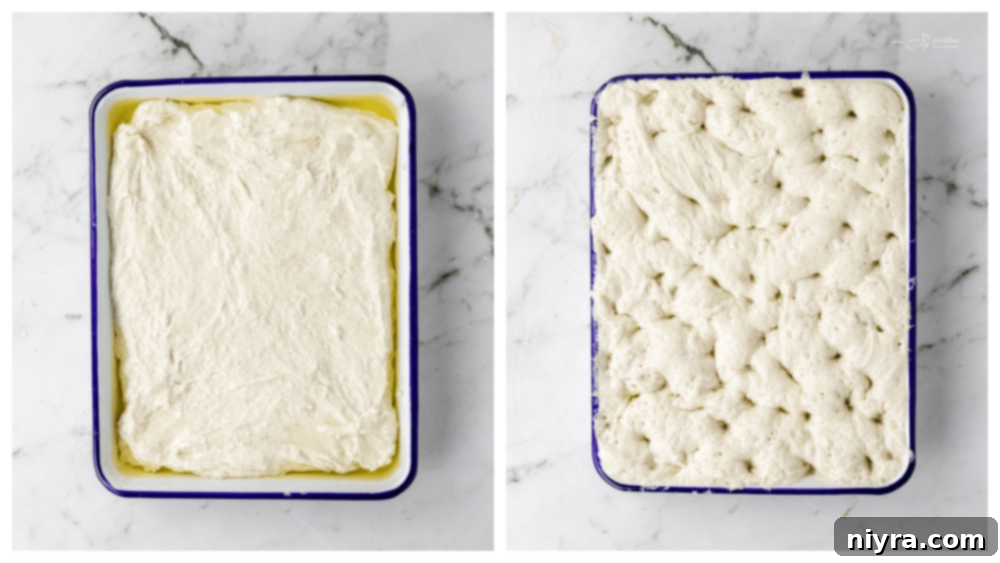
Fourth: Prepare for Rise. Pour the remaining 2 tablespoons of olive oil into a 9×13-inch rectangular baking pan, ensuring the entire bottom and sides are coated. Scoop the sticky dough into the oiled pan. Gently spread it out somewhat with your hands, allowing the oil to seep around and under the dough. Cover the pan loosely with plastic wrap or a clean kitchen towel and let the dough rise in a warm place for 1 hour. It should double in size and become visibly puffy.
Fifth: Preheat Oven. While the dough is completing its rise, preheat your oven to 375 degrees F (190°C). This ensures the oven is at the correct temperature for even baking when the focaccia is ready.
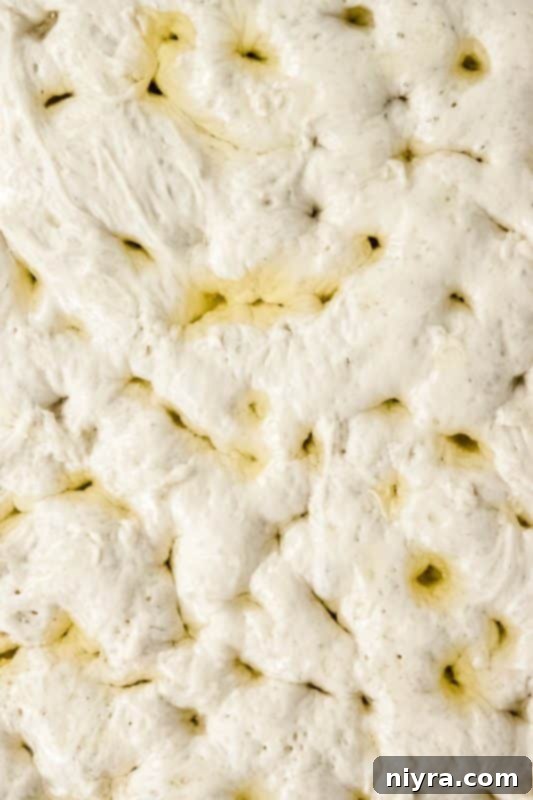
Sixth: Dimple and Season. Once the dough has risen, gently use your fingers to poke deep holes all over the surface. These dimples are characteristic of focaccia and allow olive oil to pool, creating pockets of flavor and a fantastic texture. Drizzle the dough with a little extra olive oil and sprinkle generously with salt. This step is crucial for that authentic focaccia flavor and crispy top.
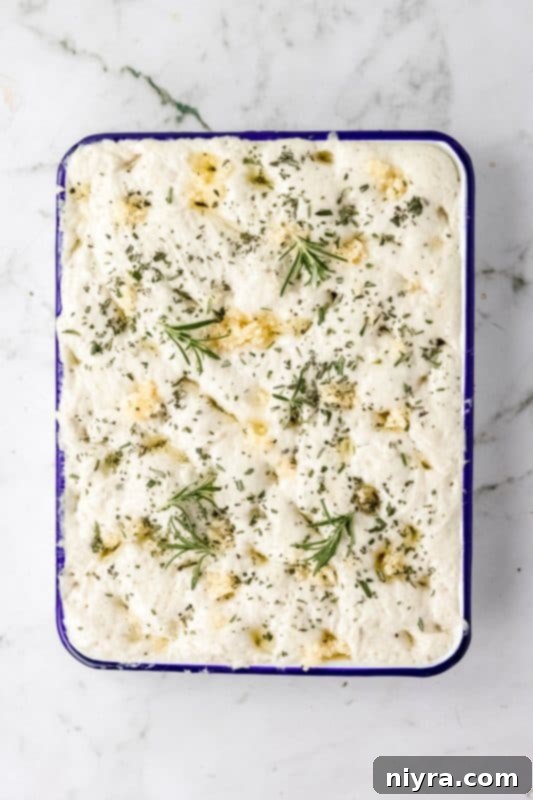
Seventh: Add Toppings and Bake. Evenly scatter the minced garlic and chopped fresh rosemary over the dimpled and oiled dough. Place the pan into the preheated oven and bake for 25-30 minutes, or until the focaccia is beautifully golden brown on top and feels firm to the touch. The bottom should also be golden and crispy due to the generous olive oil in the pan.
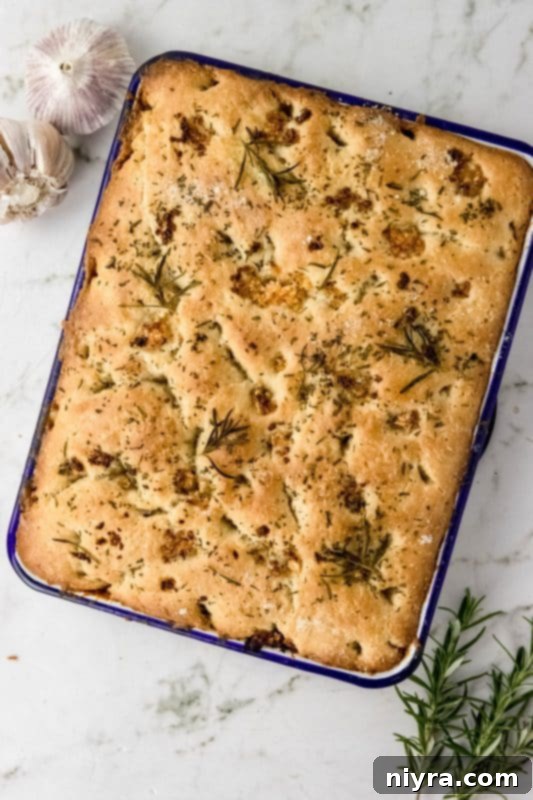
Once baked, remove the focaccia from the oven and let it cool slightly in the pan before transferring it to a wire rack to cool completely. Allowing it to cool to room temperature helps the flavors meld and prevents it from becoming soggy. Leftover focaccia can be stored, covered with plastic wrap or aluminum foil, at room temperature for 3-4 days. For longer storage, you can freeze the bread for up to 3 months. To reheat, a few minutes in a toaster oven or oven will bring back its crispy exterior.
This aromatic bread is excellent served with a variety of accompaniments. Try it with a flavorful herbed dipping oil, a rich marinara sauce, or a creamy hummus. It also pairs wonderfully with soups, salads, and any Italian-inspired meal.
Tips for Perfect Focaccia Every Time
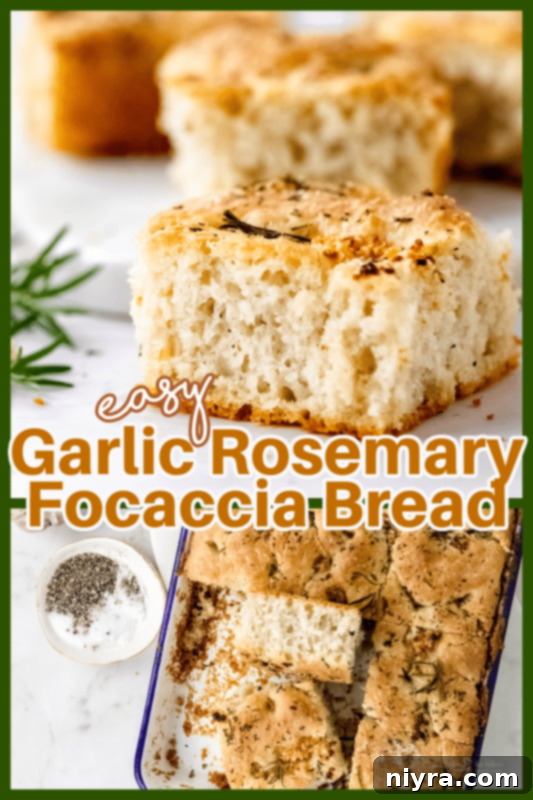
Mastering focaccia is simpler than you think, especially with these helpful tips and tricks to guide you:
Don’t Be Afraid of Olive Oil: Focaccia is known for being rich in olive oil. Don’t skimp on it, especially when oiling the pan and drizzling over the top. It contributes immensely to the flavor, crust, and overall texture.
Warm Place for Rising: A consistently warm environment is key for yeast activity. If your kitchen is cool, place the covered dough in a slightly warmed, turned-off oven or near a sunny window.
The Dimpling Process: When poking the dough, aim to create deep indentations without completely deflating the dough. These dimples capture the olive oil and create fantastic pockets of flavor and texture.
Don’t Overwork the Dough: Focaccia dough is meant to be a bit sticky and shaggy. Overworking it can lead to a tough bread. Mix just until combined.
Listen to Your Oven: Baking times can vary. Keep an eye on your focaccia and trust your instincts. It should be deeply golden brown for the best flavor and texture.
Cool Before Slicing: While it’s tempting to cut into warm bread, letting the focaccia cool slightly allows the internal structure to set and the flavors to fully develop.
Love it? Pin it!
If you love this recipe for the best homemade focaccia bread, make sure you don’t lose it! Pin it to your favorite Pinterest recipe board now so you can easily find it whenever a craving strikes!
Frequently Asked Questions About This Easy Focaccia Recipe
Curious about focaccia? Here are answers to some common questions that will help you master this delicious Italian flatbread:
- How is focaccia different from other breads? Focaccia is a unique yeasted flatbread. Unlike traditional sandwich bread, it’s typically baked in a baking pan and doesn’t aim for a high, airy loaf. Instead, it boasts a crispy, golden top and bottom crust with a wonderfully airy and chewy interior, often characterized by its signature dimples.
- What makes focaccia bread special? Focaccia’s uniqueness comes from its texture and rich flavor. It’s often made with a higher proportion of yeast, protein (from flour), and fats (especially olive oil) compared to many other breads. This combination contributes to its distinctive crisp-chewy texture and robust taste. The generous use of olive oil is also a hallmark, contributing to both its flavor and its golden crust.
- What’s the best way to eat focaccia bread? Focaccia is incredibly versatile! You can savor it simply, dipped in good quality balsamic vinegar or extra virgin olive oil. It makes an excellent base for a gourmet focaccia sandwich with your favorite fillings like cured meats, cheeses, and fresh vegetables. It’s also fantastic torn into pieces for dipping into soups, stews, or rich sauces, and can even serve as a delightful substitute for pizza dough, offering a thicker, chewier crust.
- What do Italians call focaccia? In Italy, it is simply called “focaccia.” The name itself is derived from the Latin “panis focacius,” meaning “hearth bread,” reflecting its ancient origins baked in ashes or on a hearth.
- Can I make this recipe gluten-free? Absolutely! To create a delicious gluten-free focaccia, you can substitute the all-purpose flour with a high-quality gluten-free all-purpose flour blend. Be sure to check that your chosen blend is suitable for yeast baking and consider adding a binder like xanthan gum if your blend doesn’t already contain it.
- How do you pronounce Focaccia? It is pronounced “fuh-KAW-chuh” or “fuh-KAH-chuh.”
- What exactly is Focaccia? Focaccia is an Italian flatbread, often enriched with olive oil, that can be either sweet or savory. It’s typically baked in a sheet pan, resulting in a bread with a distinctively crispy top and bottom and a soft, airy crumb. It’s a staple in Italian bakeries and homes, enjoyed at any time of day.
Creative Substitutions for Your Focaccia
One of the joys of baking is the freedom to get creative and tailor recipes to your personal taste, dietary needs, and what you have on hand. Don’t hesitate to make this focaccia recipe truly your own!
If fresh rosemary isn’t your preferred herb, feel free to substitute with other fresh herbs like thyme, oregano, basil, or a mix of Italian herbs.
No fresh herbs on hand? A good quality dried Italian seasoning blend can work wonderfully, adding a fragrant and savory depth. Use about one-third of the amount if substituting dried for fresh.
For those with gluten sensitivities or dietary preferences, try a gluten-free all-purpose flour blend. Ensure it’s a blend suitable for yeast baking for the best results, as mentioned in the FAQs.
Beyond the Basics: Focaccia Topping Ideas & Serving Tips
Unleash your culinary creativity with these inspiring tips and tricks to customize and enjoy your homemade focaccia:
Roasted Tomato Focaccia: Before baking, gently press halved cherry tomatoes onto the surface of the dough. As they roast, they’ll burst with sweet, tangy flavor, creating a beautiful and delicious topping.
Cheesy Garlic Focaccia: For an extra layer of indulgence, sprinkle a generous amount of freshly grated Parmesan cheese over the baked focaccia while it’s still warm. The residual heat will melt the cheese, creating a savory, golden crust.
Endless Topping Possibilities: The beauty of focaccia lies in its versatility. Experiment with your favorite herbs, finely sliced onions, olives, bell peppers, sun-dried tomatoes, or even thinly sliced potatoes. A combination of toppings can create a truly unique bread.
Focaccia Pizza Base: Use your baked focaccia as a rustic and delicious crust for pizza. Simply add your favorite sauce, cheese, and toppings, then bake until bubbly and golden. The thick, airy bread makes for a satisfyingly hearty pizza.
Proper Storage: To keep your leftovers fresh and flavorful, store them in an airtight container or tightly wrapped in plastic wrap or foil at room temperature for up to 3-4 days. For longer storage, freeze slices for quick enjoyment later.
More Delicious Bread Recipes to Love
If you enjoyed making this focaccia, you’ll love exploring these other delightful bread recipes:
- Homemade Cinnamon Pull Apart Bread (pictured above)
Easy Sourdough Focaccia
Olive Garden Breadsticks (Copycat)
Simple Peasant Bread
Traditional Irish Soda Bread
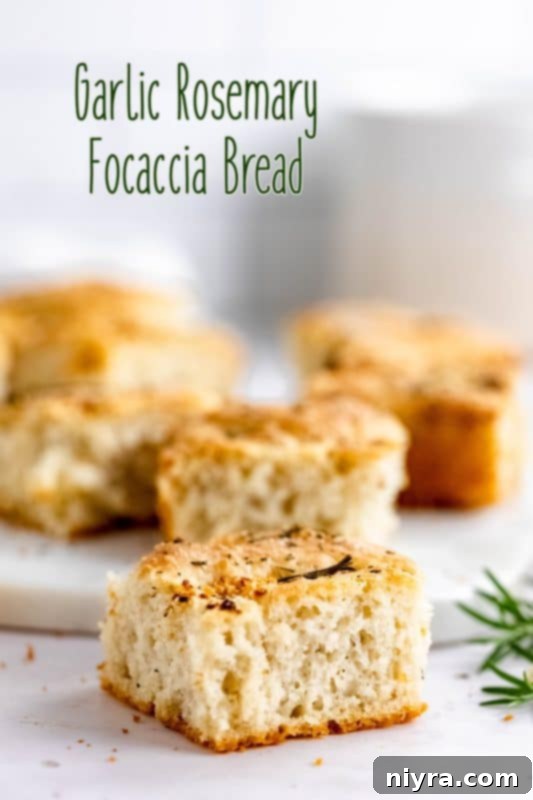
Savor the perfect blend of pungent garlic and fragrant rosemary in every bite of this crispy and chewy Garlic Rosemary Focaccia bread. It’s a versatile and satisfying addition that makes a great accompaniment to any meal, any night of the week. Enjoy the rewarding experience of baking this Italian classic at home!

LIKE THIS RECIPE?
Don’t forget to give it a ⭐️⭐️⭐️⭐️⭐️ star rating and
leave a comment below the recipe!

Garlic Rosemary Focaccia Bread
Loaded with flavor, this Garlic Rosemary Focaccia Bread recipe turns out with a crispy, golden crust on both the top and bottom with an airy texture inside. Perfect for dipping, dunking, or sandwich making.
Equipment
- Herb Scissors
- Whisks for Cooking, 3 Pack Stainless Steel Whisk
- Kitchenaid Stand Mixer
- KitchenAid Hand Mixer
- 9×13 Pyrex Baking Dish with a Lid
Ingredients
- 5 Tablespoons olive oil
- 1 1/2 cups warm water
- 2 teaspoons salt
- 3 1/2 cups all purpose flour
- 1 Tablespoon instant dry yeast
- 4 garlic cloves minced
- Fresh rosemary sprigs, chopped
Instructions
- In a large mixing bowl, combine the flour, salt and yeast. Whisk well.
- Create a well in the center of the flour mixture and add the warm water and 3 tbsp olive oil.
- Use your hands or an electric mixer to beat the dough until well combined. 1-2 minutes.
- Pour the remaining 2 Tablespoons olive oil into a 9×13-inch pan and scoop the batter into the oiled pan.
- Allow to rise for 1 hour in a warm place.
- Preheat the oven to 375 degrees F.
- Using your fingers, gently poke the dough to create holes. Drizzle the dough with a little extra olive oil and sprinkle with salt.
- Add the garlic and rosemary.
- Bake for 25-30 minutes or until golden brown.
Nutrition
Calories: 187kcal |
Carbohydrates: 29g |
Protein: 4g |
Fat: 6g |
Saturated Fat: 1g |
Polyunsaturated Fat: 5g |
Sodium: 355mg |
Fiber: 1g
